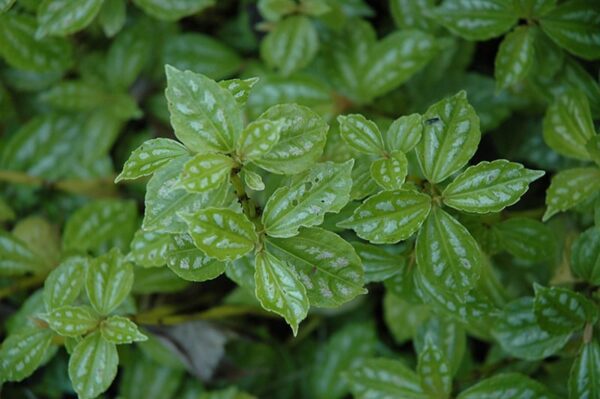Images provided by NetPS Plant Finder Tool
Aluminum Plant
Rich, deep green oval leaves that look like they have been splashed with aluminum paint, hence the name; pinch stem tips to keep plant compact; a great annual base or edging plant; requiring only bright indirect light, this one is a great houseplant
Please contact your local store for product availability.
Find a garden center near you.
Species: cadierei
Other Species Names: Watermelon Plant
Plant Height: 12 in.
Spread: 10 in.
Evergreen: Yes
Plant Form: mounded
Summer Foliage Color: dark green
Minimum Sunlight: shade
Maximum Sunlight: shade
Aluminum Plant's attractive serrated oval leaves remain dark green in color with showy silver variegation throughout the year. Neither the flowers nor the fruit are ornamentally significant.
Aluminum Plant's attractive serrated oval leaves remain dark green in color with showy silver variegation throughout the year. Neither the flowers nor the fruit are ornamentally significant.
Aluminum Plant will grow to be about 12 inches tall at maturity, with a spread of 10 inches. When grown in masses or used as a bedding plant, individual plants should be spaced approximately 8 inches apart. Its foliage tends to remain dense right to the ground, not requiring facer plants in front. Although it's not a true annual, this plant can be expected to behave as an annual in our climate if left outdoors over the winter, usually needing replacement the following year. As such, gardeners should take into consideration that it will perform differently than it would in its native habitat.This plant should only be grown in a shady location. It does best in average to evenly moist conditions, but will not tolerate standing water. It is not particular as to soil pH, but grows best in rich soils. It is somewhat tolerant of urban pollution. This species is not originally from North America. It can be propagated by cuttings.Aluminum Plant is a fine choice for the garden, but it is also a good selection for planting in outdoor containers and hanging baskets. It is often used as a 'filler' in the 'spiller-thriller-filler' container combination, providing a canvas of foliage against which the thriller plants stand out. Note that when growing plants in outdoor containers and baskets, they may require more frequent waterings than they would in the yard or garden.
How to Care for an Aluminum Plant
Aluminum Plants grow best in bright, indirect light. Too much direct sunlight can scorch their silvery leaves, while too little light may cause the foliage to lose its metallic sheen and the stems to stretch. A spot near an east- or north-facing window is ideal. They can also thrive under fluorescent or LED grow lights indoors.
This tropical plant prefers well-draining, rich potting soil with good moisture retention. A mix containing peat moss, perlite, and compost works well. Consistent drainage is important to prevent soggy roots—using a pot with drainage holes helps ensure healthy growth.
Keep the soil evenly moist but never waterlogged. Water when the top inch of soil feels dry, and reduce watering slightly in winter when growth slows. Aluminum Plants prefer moderate humidity, so mist occasionally or use a humidity tray if the air is dry.
Feed your Aluminum Plant every 4–6 weeks during spring and summer with a balanced, water-soluble houseplant fertilizer diluted to half strength. Avoid over-fertilizing, which can cause leaf burn or mineral buildup. Skip feeding during fall and winter dormancy.
Prune regularly to maintain a compact, bushy shape. Pinch back the growing tips or trim leggy stems to encourage branching. Remove any yellow or damaged leaves as needed. Pruning also helps rejuvenate older plants and improve airflow.
Common pests include aphids, mealybugs, and spider mites, especially in dry indoor air. Wipe leaves regularly and keep humidity moderate to deter infestations. Overwatering can lead to root rot or fungal leaf spots, so ensure good drainage and airflow.
No—Aluminum Plants are not frost-tolerant. They thrive in temperatures between 60°F and 75°F and should be kept indoors or protected from cold drafts. Exposure below 50°F can damage the leaves and stunt growth.
